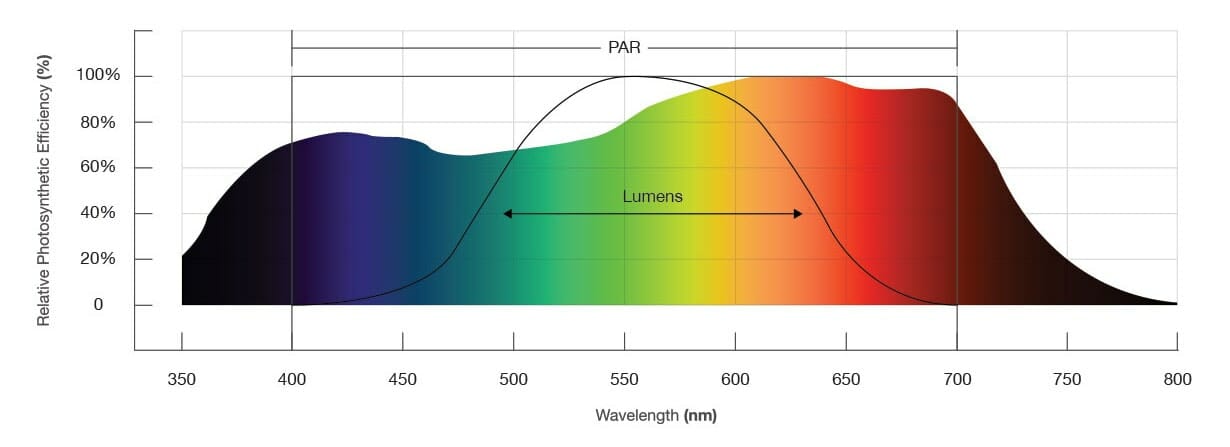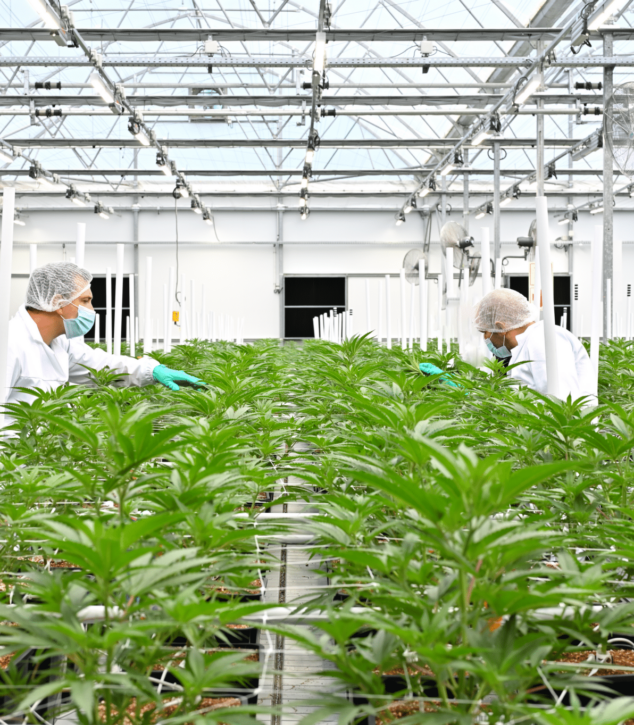Understanding The Numbers
If you have been researching LED horticulture lighting systems for your plant growth facility, you have likely been bombarded with a variety of metrics that lighting manufacturers use to market their products. Some terms and acronyms you are likely to see include: watts, lumens, LUX, foot candles, PAR, PPF, PPFD, and photon efficiency. While all of these terms do relate to lighting, only a select few really tell you the important metrics of a horticulture lighting system. The purpose of this article is to define these terms and acronyms, correct some common misunderstandings, and help growers understand which metrics are applicable to horticulture lighting systems, and which ones are not.
Humans Use Lumens
Plants and people perceive light very differently from one another. Humans and many other animals use something called photopic vision in well-lit conditions to perceive color and light. Lumens are a unit of measurement based on a model of human eye sensitivity in well-lit conditions, which is why the model is called the photopic response curve (Figure 1). As you can see, the photopic response curve is bell shaped and shows how humans are much more sensitive to green light, than blue or red light. LUX, and foot candle meters measure the intensity of light (using lumens) for commercial and residential lighting applications, with the only difference between the two being the unit of area they are measured over (LUX uses lumen/m2 and foot candle uses lumen/ft2).

Using LUX or foot candle meters to measure the light intensity of horticulture lighting systems will give you varying measurements depending on the spectrum of the light source, even if you are measuring the same intensity of PAR.
The fundamental problem with using LUX or foot candle meters when measuring the light intensity of horticulture lighting systems is the underrepresentation of blue (400 – 500 nm) and red (600 – 700 nm) light in the visible spectrum. Humans may not be efficient at perceiving light in these regions, but plants are highly efficient at using red and blue light to drive photosynthesis. This is why lumens, LUX, and foot candles should never be used as metrics for horticulture lighting.
What is PAR
PAR is photosynthetic active radiation. PAR light is the wavelengths of light within the visible range of 400 to 700 nanometers (nm) which drive photosynthesis (Figure 1). PAR is a much used (and often misused) term related to horticulture lighting. PAR is NOT a measurement or “metric” like feet, inches or kilos. Rather, it defines the type of light needed to support photosynthesis. The amount and spectral light quality of PAR light are the important metrics to focus on. (To find out more about spectral light quality click here). Quantum sensors are the primary instrument used to quantify the light intensity of horticulture lighting systems. These sensors work by using an optical filter to create a uniform sensitivity to PAR light (Figure 1), and can be used in combination with a light meter to measure instantaneous light intensity or a data logger to measure cumulative light intensity.
Three important questions you should look to be answered when researching horticulture lighting systems are:
- How much PAR the fixture produces (measured as Photosynthetic Photon Flux)?
- How much instantaneous PAR from the fixture is available to plants (measured as Photosynthetic Photon Flux Density)?
- How much energy is used by the fixture to make PAR available to your plants (measured as Photon Efficiency).
The three key metrics used to answer these questions are:
Conclusion
In order to invest in the proper horticulture lighting system to meet your cultivation and business goals, you need to know the PPF, PPFD, and photon efficiency to make informed purchasing decisions. However, these three metrics should not be used as sole variables to base a purchasing decisions. There are several other variables such as form factor and coefficient of utilization (CU) that need to be considered as well.
All factors need to be used in combination to select the most appropriate systems based on your cultivation and business goals, and the take home message is that PPF, PPFD, and photon efficiency are the proper metrics used by scientists and industry leading horticulture lighting companies. If a company does not provide you with the correct metrics used for horticulture lighting, they should not be selling horticulture lighting systems, and you will not be able to verify the true efficacy of their system. Fluence Bioengineering always publishes these metrics in product literature and is one of the leaders in photosynthetic photon efficiency as verified by Rutgers and Utah State University.




